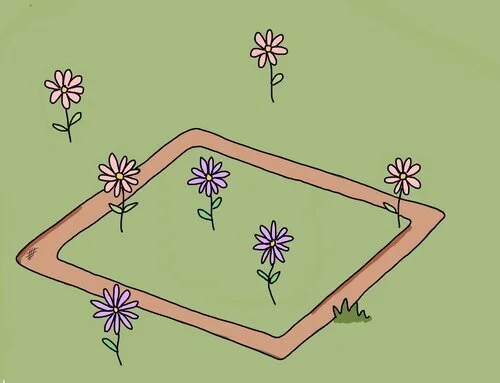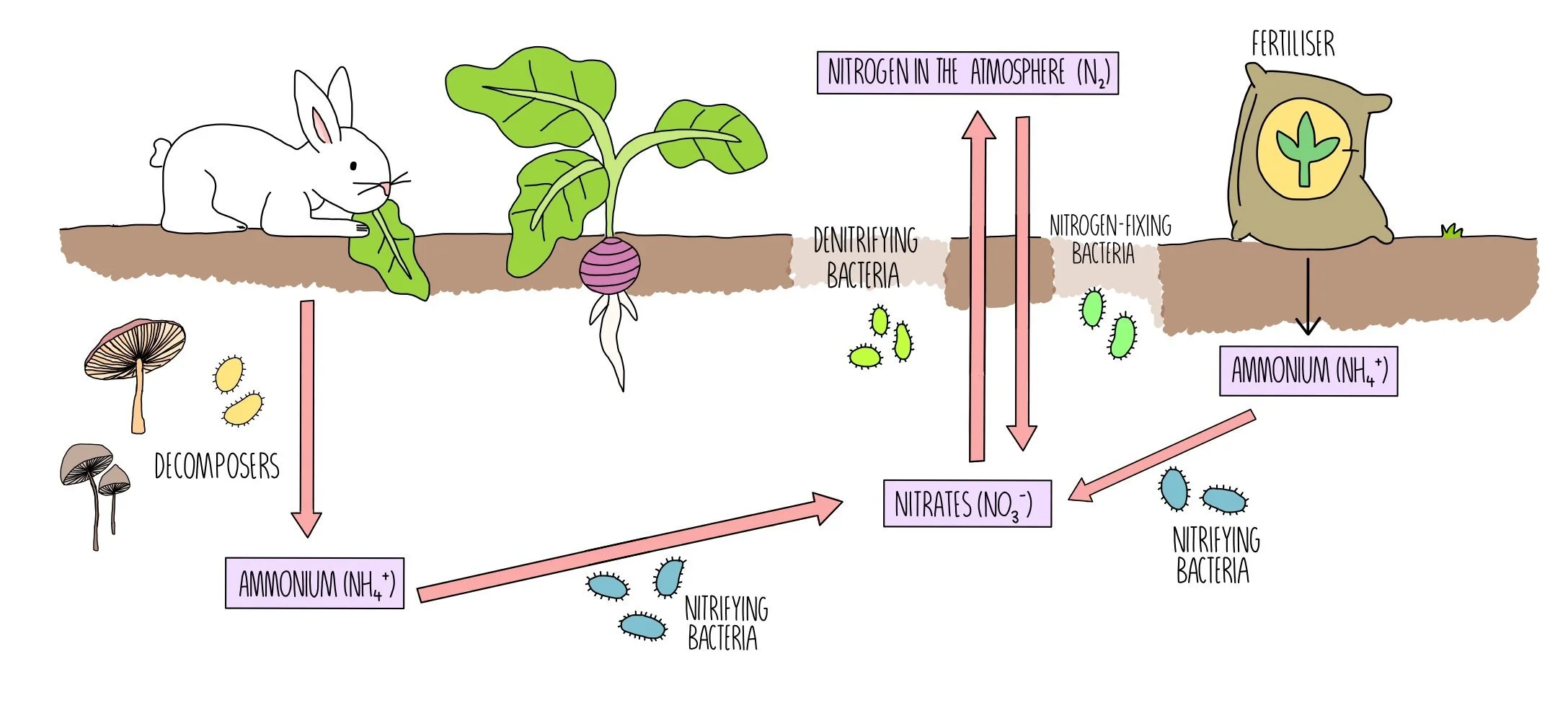Organisation of an Ecosystem
Organisms living in an ecosystem feed off each other and transfer energy along a food chain. Energy isn’t the only thing passed around an ecosystem - nutrients and compounds also cycle from one organism to another.
Levels of organisation
We can use food chains to show which organisms feed on other organisms — and therefore the flow of energy.
Energy always starts from the Sun and is converted into glucose by photosynthesis in green plants. Glucose is respired, releasing energy to help the organism to grow (increase in biomass).
Organisms which produce biomass by capturing the energy from sunlight are called producers — they are always at the beginning of the food chain.
An organism which feeds on a producer are called primary consumers and will also be herbivores, since producers tend to be mostly green plants.
The next organism in the food chain is the secondary consumer which will be eaten by the tertiary consumer.
The arrows always point from the organism being eaten to the organism which feeds on it.
Predator-prey relationships
A predator is an animal which hunts and kills other animals and prey are the animals which are hunted and eaten.
In a stable community, the numbers of predators and prey rise and fall in cycles.
Whenever the population size of prey increases, this causes the population size of the predator species to increase because more food is available.
The increase in the predator population causes a decrease in the prey population because there are more predators to feed on the prey.
This causes a drop in the prey population size, which reduces the food availability for the predators, which in turn leads to a reduction in the predator population.
Estimating population size
Measuring the population size (abundance) of a species by trying to count all of the individuals in the habitat would not only be pretty tricky but also considerably time-consuming. To save time, ecologists take a sample of the habitat and use that to estimate the size of the population in the whole habitat.
For species which don’t move, such as plants, quadrats are typically used. It is important that quadrats are placed randomly within the habitat to avoid bias. This can be done by using a tape measure to plot out the habitat as a grid and using a random number generator to plot coordinates. A large number of quadrats will be randomly placed throughout the habitat to ensure the data collected is reliable.
To see how the distribution of different species changes along a habitat, we use something called a transect, which is essentially a line placed from one part of the habitat to another. There are three different ways of using transects:
Line transect - a tape measure is placed along the line and any species which touch the tape measure will be recorded.
Belt transect - quadrats are placed along the transect one after another, so that each quadrat is touching
Interrupted transect - quadrats are placed at regular intervals along the transect
How materials are cycled
All materials within the living world are recycled to be used as the building blocks for other living organisms. For example, the nitrogen that is a component of the proteins in plants is transferred to animals when animals eat the plants. The animal will use the nitrogen to make their own proteins. When the animal dies, the nitrogen will be returned to the soil and can be absorbed by other plants. Just like nitrogen, other atoms are constantly moving through different organisms within the ecosystem.
The carbon cycle describes the movement of carbon through an ecosystem.
Carbon is added to the atmosphere when respiration of living organisms and combustion of fossil fuels release carbon dioxide into the air.
The carbon dioxide is removed from the air by plants and converted into carbohydrate during photosynthesis.
When animals eat the plants, they incorporate the carbon into their own biological molecules, such as carbohydrate, proteins and lipids.
When animals and plants decompose, carbon is released into the atmosphere through the respiration of decomposers, such as bacteria and fungi.
The carbon in any remaining dead material will eventually form fossil fuels after millions of years of compression beneath the Earth’s surface.
Water also moves in cycles through an ecosystem in the water cycle.
Some of the water on the Earth’s surface, for example in oceans, lakes and puddles, evaporates when exposed to heat energy from the Sun, forming water vapour in the atmosphere.
This condenses to form clouds which are easily blown by winds to other areas.
Precipitation of the water droplets within clouds returns water back to the Earth’s surface, which is either absorbed into the ground (infiltration) or runs along the surface of the ground (surface run-off) and into streams and rivers.
Some of the water that has been absorbed by soil is taken up by plants for photosynthesis.
Some water evaporates from the surface of the leaf, through the stomata, in a process called transpiration. Transpiration creates a pulling force, resulting in the movement of water through the plant.
The nitrogen cycle
Plants can only absorb nitrogen in the form of nitrate so they depend on nitrogen-fixing bacteria to convert nitrogen in the air into nitrates in the soil. These bacteria either live freely in the soil or inside root nodules, forming a symbiotic relationship with the plant.
The Haber process is used to convert nitrogen into ammonia which is used in fertilisers. Nitrifying bacteria convert the ammonia into nitrates. Plants absorb the nitrates and incorporate the nitrogen into amino acids which are used to build proteins. The breakdown of proteins in our bodies produces urea which is removed from our body in our urine. Nitrogen is also returned to the soil by the decomposition of dead matter by microorganisms such as bacteria and fungi.
In some conditions, denitrifying bacteria convert nitrates in the soil into nitrogen in the air. This usually happens in soil which is lacking oxygen, such as waterlogged soil. Therefore, improving drainage can make soil more fertile by retaining more nitrates.
Decomposition
Fungi and other decomposers play an important role in recycling compounds through ecosystems.
Decomposers play important roles in food chains by breaking down dead matter. When organisms die, decomposers such as bacteria and fungi secrete digestive enzymes onto the dead material. The enzymes break down the molecules in the organism, converting it into simpler substances which can be absorbed by plants, allowing nutrients to be recycled within an ecosystem.
For example, decomposers will feed on fallen leaves, excreted faeces and even whole organisms, such as a dead woodlouse, causing them to decay. The protein, carbohydrate and lipid molecules which make up the organism will be broken down into simple molecules which are small enough to be absorbed by plant roots. In this way, the molecules which used to be part of the woodlouse may be used by the tree to grow more leaves, then the molecules are incorporated into the next organism when those leaves are eaten by a hungry insect.
The rate of decay is the speed at which dead matter is broken down by decomposers. It is affected by the following conditions:
Temperature – as temperature increases the rate of decay increases. This is because the enzymes in the decomposing organisms have more kinetic energy and are working faster. This is the reason why we put food in the fridge to stop it going mouldy. If temperature becomes too high, however, enzymes in the decomposing organisms will denature and the rate of decay slows down.
Water – decomposers require moist environments to survive and decay material. In dry environments, decomposers cannot survive and the rate of decay decreases. Some decomposers break down organisms by releasing digestive enzymes onto the dead matter and absorbing dissolved molecules. This process requires water for the digestive reactions to occur.
Oxygen – most decomposers require aerobic conditions to survive so if there is a lack of oxygen, the rate of decay will decrease. This is why food sealed in airtight bags will last longer than food left out in the open. There are some decomposers that are able to survive in anaerobic environments and will decompose dead material to form methane gas. This process is used in biogas generators to produce methane, which is sold as fuel.
Gardeners and farmers try to provide optimum conditions for rapid decay of waste biological material. For example, gardeners can make compost from the decomposition of food waste such as vegetable peelings. Ensuring that the food waste is kept warm (e.g. by keeping it in a shed), moist (by adding water) and oxygenated (by turning it with a garden fork to prevent it from compacting) will promote the decomposition of the food waste into compost. The compost produced is rich in carbon and nitrogen and can be added to soil as a natural fertiliser to encourage plant growth.
Impact of Environmental Change
The distribution of organisms within an ecosystem can be affected by the following environmental changes:
The distribution of monarch butterflies has been affected by climate change.
Temperature – an increasing global temperature due to global warming will affect the distribution of different species. As temperatures around the world change, organisms will move to where conditions are most suited to their survival. If they are unable to move (e.g. plants), they may become at risk of extinction. The monarch butterfly is an example of an organism that is particularly sensitive to temperature changes and its distribution within an ecosystem is already changing.
Water availability – all organisms need water to survive as it is a component of the cell cytoplasm where important chemical reactions take place. Too much water, however, can result in organisms drowning or rotting. Flooding is a consequence of climate change and some organisms may not be able to survive as regions which were previously habitable become more prone to flooding. Droughts are another consequence of climate change, resulting in a lack of water in other areas.
Composition of atmospheric gases – organisms require oxygen for respiration and plants also require carbon dioxide for photosynthesis. Marine organisms respire using oxygen that has dissolved in water. When levels of pollution increase, the levels of dissolve oxygen are reduced, making it more difficult for marine organisms to survive.
As you can see from the examples given above, these environmental changes may be part of normal seasonal fluctuations, part of geographic changes or caused by human interaction.



